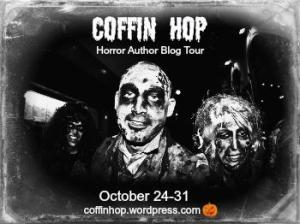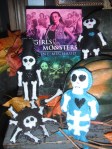A post for Halloween Eve. How
could I not discuss what scares us? Thinking about scary scenes from books and
movies, brought back a vivid memory of a movie my cousins introduced me to when
I was eleven. “The Beast with Five fingers” was made in 1947 and it was the
last movie Peter Lorrie ever made with Warner Borthers. A famous pianist dies,
his hand is severed and the hand commits murders. When the hand is thrown into a
fire, it manages to crawl out and still strangle its victim! And at the sound of piano music, the audience
knows the hand is on its way to the next victim. For months after seeing that movie, I made
sure my covers didn’t touch the floor. I knew the hand could climb, but I was
pretty sure it couldn’t jump. What scared me was the most was the possibility
of what that hand could do.
While I don’t write horror, I
do have scenes that I create to scare my readers, so I’ve spent some time
analyzing what makes a scary scene work.
Build dread through details:
A scene that terrified me as
a young reader was in The Dark is Rising by
Susan Cooper. She builds an atmosphere of dread word by word. On mid winter eve
Will Stanton is alone in his room. He lies awake in the dark listening to every
sound, recalling the strange events of the day, certain he is going mad. Up to
this point, she’s seeded the story with foreshadowing...The walker is abroad..this night will be bad…. Her description of
the moaning wind, the strange behavior of animals, the palpable presence of the
dark increases our tension. We don’t know what will happen in that room but
when the snow crashes through the skylight and a single rook feather lands on the
bed, we are as startled and horrified as Will.
Master of horror, Stephen
Kings says:
“Making people believe the unbelievable is no trick; it’s
work. … Belief and reader absorption come in the details: An overturned
tricycle in the gutter of an abandoned neighborhood can stand for everything.
Or a broken billboard. Or weeds growing in the cracks of a library’s steps. Of
course, none of this means a lot without characters the reader cares about (and
sometimes characters—‘bad guys’—the reader is rooting against).”
Focus on character
response:
Cooper builds dread not only through
the details, but in Will’s response to them. If Will’s response isn’t real
fear, ours won’t be either. Our heart rate escalates, our palms grow sweaty
along with the protagonist if the author shows us what the character is risking.
The reader’s response is in proportion to the protagonist’s. Which leads me to…
Make it worth the sweat
The dark must be worth fearing. Readers gauge their
fear by understanding consequences. If the antagonist isn’t a credible baddie,
if the reader doesn’t understand the potential of the night in the woods, the
severed hand, the discarded revolver, the scene loses power. Think about
Hannibal Lecter who “once ate a census taker's liver ‘with fava beans and
a nice Chianti.’”
Leave it to the imagination:
What scares us most is in our
own imaginations, the possibility rather than the actual. The unknown is
scarier and more enticing than the known. The skillful writer will already have
cranked the tension up with foreshadowing. Fear comes from the tension of not
knowing the outcome, but expecting the worse. Perhaps the protagonist is about
to do something stupid: go into the cellar, spend the night in a haunted house.
Readers know bad things are coming, but we don’t know how those bad things will
play out. Our own minds can be scarier than a graveyard on Halloween night. It’s
the author’s job to lead us there and then blow out the candle.
What’s your favorite scary
scene from a book or movie?







































+CROPPED.jpg)




